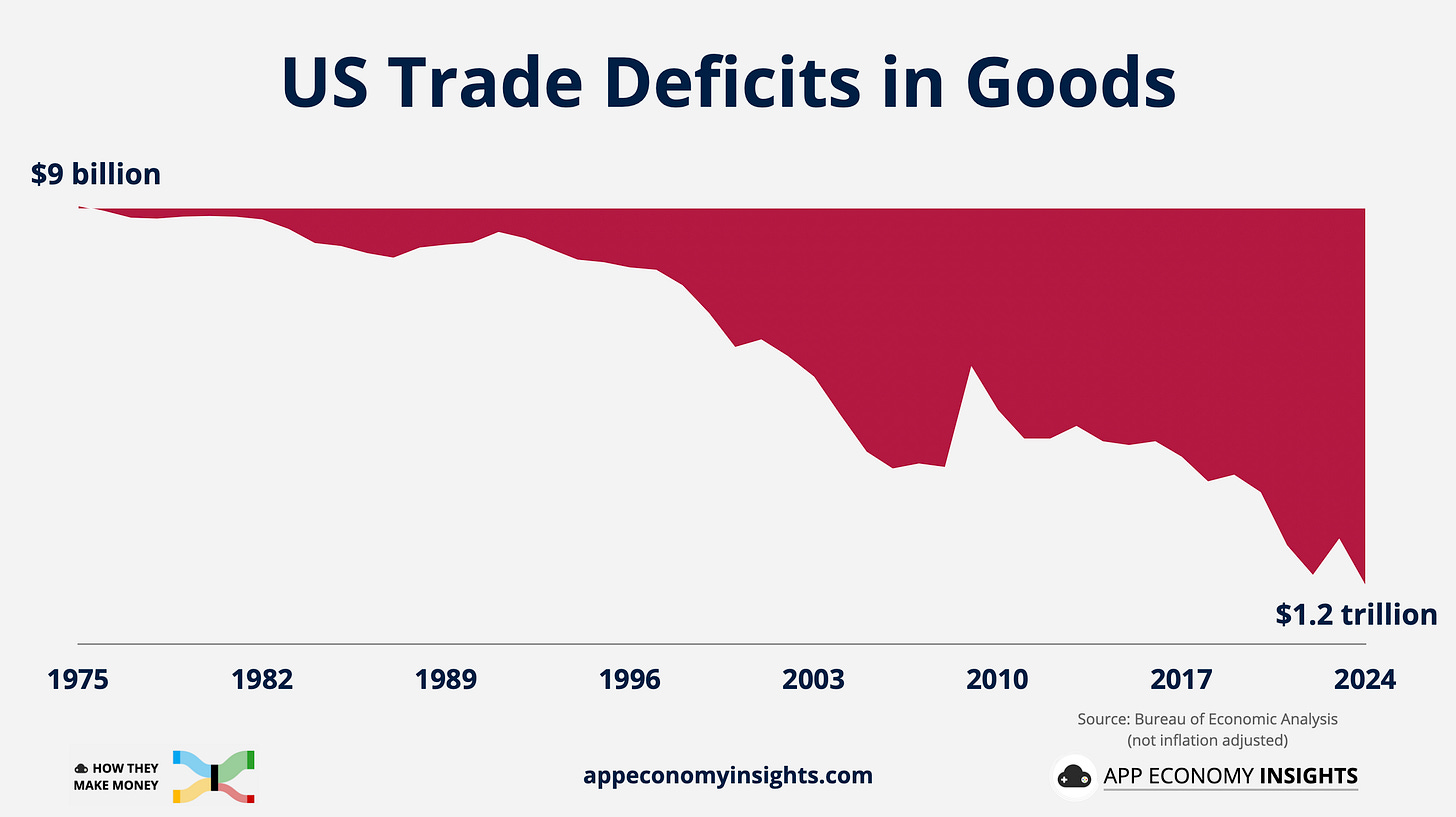📉 Tariff Shock: Who Gets Hit?
Is the Nasdaq plunge a buying opportunity?
Welcome to the Premium edition of How They Make Money.
Over 200,000 subscribers turn to us for business and investment insights.
In case you missed it:
📉The steepest US tariffs in a century just dropped—and markets are rattled.
The Trump administration has unleashed a sweeping new trade regime: a 10% tariff on all imports, with even higher rates for dozens of countries. The fallout is already visible—supply chains disrupted, inflation fears rising, and stocks sliding fast.
As Oaktree’s Howard Marks put it:
“The world economy was shook up like a snow globe.”
Policy uncertainty is now the biggest variable.
And it’s incredibly hard to forecast what happens next.
Apple has dropped 20% since the announcement. Stellantis halted production in Mexico. The Dow had its worst day since the pandemic crash. Meanwhile, gold hit a record, and Treasury yields tumbled as investors scrambled for safety.
So what do we do now?
This article is your guide through the noise to stay grounded.
Today at a glance:
📜 What just happened? The key facts behind the tariffs.
🌍 Why it matters. How tariffs ripple through the economy.
🔮 Why it’s hard to predict. The challenge of forecasting policy.
🏭 Who gets hit? Case studies of impacted companies.
🧘♂️ How to think long-term. Mindset > headlines.
✅ Key takeaways. Zooming out with clarity.
🧠 Investor lens. How to find opportunity in uncertainty.
1. 📜 What Just Happened?
America’s trade deficit has been growing for decades.
From a small surplus in the 1970s to a $1.2 trillion goods deficit in 2024, the US has become increasingly reliant on imports. This imbalance is now central to President Trump’s justification for sweeping tariffs—framing them as a way to “level the playing field.”
On April 2, Trump introduced the most aggressive US trade policy shift in decades:
A 10% universal tariff on all imports to the US.
Higher “reciprocal tariffs” on over 60 countries, calculated based on their trade surplus with the US.
China faces an additional 34% duty on top of the existing 20%.
Major partners hit include the EU, Japan, South Korea, Vietnam, and more.
Canada and Mexico are temporarily exempt from the reciprocal tariff list.
🔍 Not exactly “reciprocal”
The Trump administration pitched the new tariffs as “reciprocal”—matching what other countries charge the US. But in practice, they’re not based on actual tariff schedules. Instead, the White House used a rough formula:
Trade deficit ÷ total exports × ½That means the new tariffs are based on how much a country exports to the US without importing in return—not the actual duties they impose. It’s more about punishing trade surpluses than matching trade rules.
👉 The administration argues the formula accounts for broader trade barriers, including non-tariff barriers like quotas, subsidies, and burdensome regulations. But critics say it oversimplifies—and risks escalating tensions based on vague or subjective measures.
The result? A hit list of top trade deficit partners. The tariffs disproportionately target countries where the US buys more than it sells—regardless of their actual import duties. As shown below, China and the European Union have the largest goods trade imbalances with the US, making them prime targets under the new formula.
📦 Hundreds of goods are affected, including electronics, autos, clothing, food, and luxury items like wine and watches.
🛑 Some sectors are spared—for now. Semiconductors, critical minerals, and pharmaceuticals were left off the initial list but flagged for possible future tariffs.
⏱️ Timing:
The 10% baseline tariff took effect at midnight on April 5.
Higher country-specific tariffs go into effect on April 9.
In response, China retaliated with its own 34% blanket tariff on US goods and restricted exports of several rare earth materials critical to tech and defense industries.
Other countries are weighing similar responses. The EU is reportedly considering targeted tariffs on US tech firms, while allies like Japan and Thailand have expressed “regret” and opened negotiations for exemptions.
2. 🌍 Why It Matters
These new tariffs touch everything—from prices at checkout to stock valuations.
Tariffs raise costs. US companies that rely on imports now face higher input prices. That includes retailers, automakers, apparel brands, and electronics giants. Many could pass those costs on to consumers, driving up prices on everyday goods—from phones and shoes to coffee and chocolate.
US importers, not foreign countries, typically foot the bill. Those costs often trickle down the chain, eventually landing with American households and small businesses. In effect, tariffs function like a hidden sales tax.
Low-income households will feel it most. Basic necessities make up a larger share of their budgets, and even small price increases hit harder. Analysts warn this is effectively a regressive tax.
Businesses are caught in limbo. With supply chains scrambled and margins under pressure, companies may pause hiring, delay investments, or cut costs. Some are already halting production.
Market confidence has cracked. The selloff isn’t just about economics—it’s about uncertainty. If these policies escalate or change on a whim, forecasting becomes nearly impossible.
In short: this is more than a trade story. It’s a macro shock—one that hits consumers, companies, and markets all at once.
3. 🔮 Why It’s Hard to Predict
The biggest challenge with these tariffs? No one knows what comes next.
As Howard Marks put it,
“We know much less today than usual. […] If you tell us what our own rules will be six months from now, I’ll bet you’re wrong.”
Trade policy has become fluid—almost improvisational. Tariffs are announced, amended, reversed, and negotiated in real time, often via social media or press conferences. That makes it nearly impossible for businesses—or investors—to plan with confidence.
Trump has already hinted that some tariffs may be rolled back in exchange for concessions, including on TikTok and fentanyl enforcement. Meanwhile, countries like China and the EU are launching swift retaliation, raising the stakes further.
On Monday, Trump threatened to impose an additional 50% tariff on China unless Beijing withdraws its 34% retaliation. He added that talks would be “terminated” if no deal is reached by April 8. Indexes dipped further on the news.
Just days earlier, he had a “very productive call” with Vietnam’s leadership—hinting that the newly announced 46% tariff could drop if a deal is reached. Apparel stocks like Nike and Lululemon have been a rollercoaster, swinging 5% or more based on the flavor of the day.
Even if tariffs are softened down the line, the damage to predictability is done. Companies may still delay hiring or investment, unsure whether the rules will stick. Markets aren’t just reacting to the policy—they’re reacting to the lack of clarity around it. And that can be even more destabilizing than the tariffs themselves.
This kind of volatility reinforces the point: policy is being made—and unmade—in real time.
4. 🏭 Who Gets Hit?
Not all companies are affected equally. Businesses with global supply chains, heavy import reliance, or exposure to retaliatory tariffs are the first to feel the pressure.
Here are a few high-profile examples:






